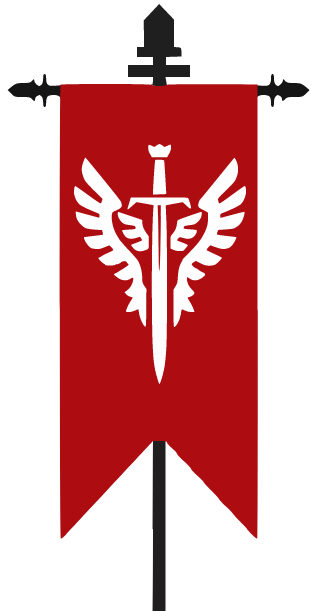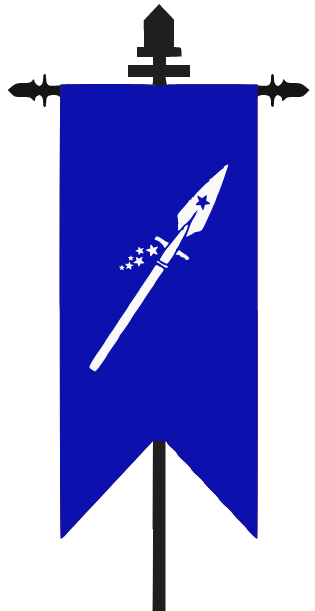The Three Houses
Created by Claire Cavendish on Tue Jan 31st, 2023 @ 11:06
The house system is a traditional feature of schools in the United Kingdom. The school is divided into sub-units called "houses" and each student is allocated to one house at the moment of enrolment. These three Houses compete with one another through extracurricular activities such as sports, science fairs, and other ways. It provides a focus for sense of belonging, community, and loyalty. Avalon introduced the House system in the school year that started September '91, when the Institute had grown to over 150 active students. Currently each house has around 100 students each.
After a naming contest within the student body the houses were named for artefacts associated with the King Arthur myth (runners up were Greek Mythology animals, and Seelie court nobility). Though the choice was made to leave out Excalibur as it was thought to evoke feelings of superiority in those that would be assigned to a house named after the mythical sword that made Arthur King of England.
 |
 |
 |
|---|---|---|
Clarent House |
Pridwen House |
Rhongomiant House |
| Clarent is King Arthur's ceremonial sword. It's name signifies that it is a "Sword of Peace", and Arthur is said to have inherited it from Uther. Arthur used it in rituals such as crowning and knighting, but was never said to have used it in battle. The Clarent house colour is Red and the banner shows a sword with wings | Pridwen has been interpreted as meaning "blessed form", it was the Shield of King Arthur in Welsh Arthurian legends. It is said that carrying the shield would prevent one from acts of cowardice. The Pridwen house colour is Green and the banner shows a shield with four squares alternating black and white with a starburst at the centre. | Translated as "Slaying Spear," "Cutting Spear" or "Striking Spear", Rhongomiant was the spear of King Arthur in the Welsh Arthurian legends. Unlike many of Arthur’s other weapons and artifacts, Rhongomiant has no apparent magical powers. Rhongomiant house colour is Blue and the banner shows the spear with a star shaped blade as well as a star pattern trail. |
House Cups
To encourage team work and an element of friendly competition Avalon Institute organises a House Cup four times a year coinciding with what would traditionally be national school holidays. Since the primary directive of Avalon is for developing mutants to hone and train their abilities most events are run without restriction of the use of powers, with the only caveat that they may not be used in a way that would harm other contestents or break the spirit of the games (an exception is in place for the Spring Cup).Autumn Cup
The Autumn Cup is all about survival, innovation, and creativity. The main structure around which it's based is a scavenger hunt in three legs.
Leg 1: The cup kicks off with a bathtub race, in which all teams are given the same type of bathtub with the goal to create a boat that can hold at least four members of the team. The 'boats' are raced to an island in the Loch, where each team gets instructions for the rest of the scavenger hunt from one of their House mentors as well as a large pumpkin carved by the house during the week leading up to the race. The Pumpkin has to survive all the trials in the scavenger hunt or a team gets a penalty. Once the teams leave the island it is allowed for teams from other houses to try and harm the pumpkins, which is why most bathtubs get built with a locked box in them.
Leg 2: Once the boat leaves the island the instructions given are in the form of a map of the surrounding area. The teams are expected to read the map and navigate around different parts of the Loch (different teams get different instructions as to avoid them simply following each other). Through the different navigation points the teams can only successfully complete tasks if they do them with the Pumpkin in tow.
Leg 3: Each of the navigational points reward pieces of a puzzle. All the teams from a House need to bring these back to the Institute and come up with the solution to the Logic puzzle. First team to do so gets the location of their House Banner.
Final scores: Aside from points for speed (first team back gets 25 points, second team gets 18, and so on), teams are also scored on creativity and mechanical design for their Bathtub boats, the carving and decorations of the Pumpkin, and the house banner they retrieve upon completing the puzzle. Points are deducted per team that is not able to bring back their Pumpkin in one piece.
Winter Cup
Nearly as important as the day of the Winter Cup itself is the week leading up to the final day before Christmas break. The entire week leads up to an open house for friends and family of the students as well as a select group of town folk, in the first year this day of festivities was dubbed the Winter Crest Festival. In the week leading up to it the students work to create items (like woodcarvings, paintings, baubles, etc) and food (like cookies, bread, etc) for sale as well as cultural performances like dance routines, live music, and plays. They are expected to create the things needed for all of these as well as marketing materials.
The winner of the Winter Cup is determined by a combination of sales as well as attendance (no entry fees are charged for the cultural performances). These numbers are added up to scores given for the marketing materials by independent faculty.
Spring Cup
Not nearly as elaborate as some of the other cups the Spring cup is all about traditional sports. During these sports regular rules are observed and none of the participants may use any of their mutant abilities and compete in one of three sports, Football, Volleyball, or Tennis (played in doubles).
Each of the individual sports is divided into age brackets, and the teams compete over the course of a week leading up to a grand finale the day before Spring break.
Points are awarded to each house based on the results of the tournaments, which could mean that a House wins without having won a single final game (by coming in second in all disciplines, for example).
Summer Cup
The exact details for the Summer Cup are different every year, but it's based around 6 elaborate games that require team coordination and improvisation to successfully complete. The games themselves are usually played Team versus Team, with no more than ten players per team. Winners get points, and a Joker can be used to double the points earned in one game per event.
The games themselves are changed every year and none of the participating parties may know what games are planned exactly, so their preparation has to be very general, usually focusing on communication and improvisation as well as physical coordination and conditioning. Since this cup takes place in the last week before summer break a lot of the games involve water elements.
The winning house is the house whose teams accumulate the most points throughout all the different games.
Previous House cup Results
Year One- 1991 Fall - Pridwen
- 1991 Winter - Pridwen
- 1992 Spring - Rhongomiant
- 1992 Summer - Clarent
- 1992 Spring - Rhongomiant
- 1991 Winter - Pridwen
- 1992 Fall - Pridwen
- 1992 Winter - TBD
Categories: Avalon, the Educational Institute

